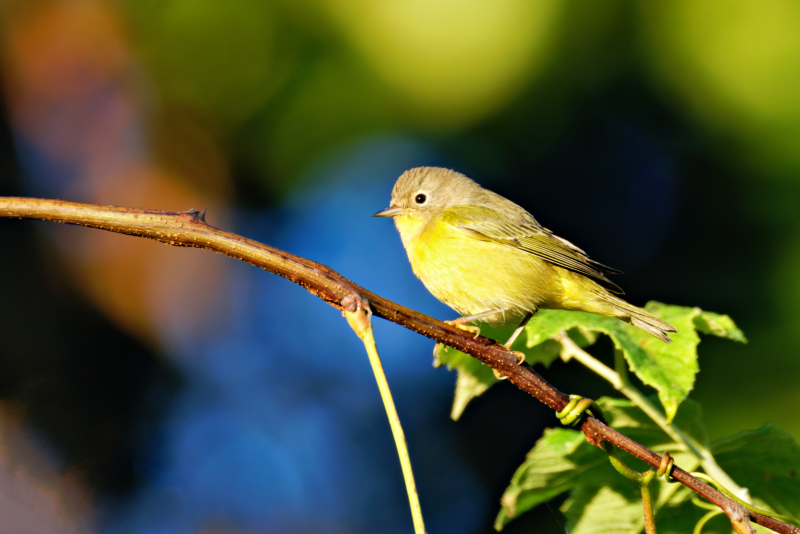On September 30, I made my way to the Sequoyah National Wildlife Refuge in Oklahoma, a place that always offers something special for a wildlife photographer. This time, I was fortunate enough to spot a beautiful Nashville Warbler. A big shout-out to Mia McPherson for helping me with the identification!
While this little warbler was busy splashing around in water that had pooled in the leaves of a bush near the road, I didn’t manage to capture that moment, but I did get a nice shot of it perched on a branch afterward.

Let’s dive into some interesting facts about this vibrant warbler.
Appearance and Behavior
The Nashville Warbler is a small but colorful bird, with some distinctive features that make it stand out among other songbirds:
- It has a gray head, which contrasts beautifully with its bright yellow throat and underparts.
- Its back and wings are a soft greenish color, blending into the natural surroundings.
- A bold white eye-ring is another key identifier, giving it a curious look.
- Unlike some warblers, it lacks wing bars, keeping its plumage simple yet striking.
Male Nashville Warblers have a hidden treasure: a rusty brown patch on their crown, though it’s often concealed. One fun behavior to watch for is how they frequently flick their tails while foraging for insects in the lower parts of trees and shrubs.
Range and Habitat
Despite its name, the Nashville Warbler doesn’t actually call Nashville, Tennessee, home. In fact, it only passes through the area during migration. This bird has two primary breeding regions:
- Canada and the northeastern United States
- The western United States
They tend to breed in open, mixed woodlands, bogs, and shrubby areas.
During winter, these warblers migrate to:
- Southern California and Texas
- Mexico
- Parts of Northern Central America, including Guatemala and El Salvador
Nesting and Reproduction
Nashville Warblers have some interesting habits when it comes to nesting:
- They build their nests on the ground, hidden beneath shrubs for protection.
- The nests themselves are open cups made of bark strips, leaves, and moss, lined with softer materials like feathers or hair.
- Typically, the female lays 4–5 eggs per clutch and handles incubation on her own. However, the male is not off the hook, he delivers food to the female while she incubates the eggs.
- The young leave the nest approximately 11 days after hatching, quickly learning the ropes of life in the wild.
Migration and Conservation
The migration patterns of the Nashville Warbler are fascinating:
- Unlike some warblers that take the bold route and fly directly across the Gulf of Mexico in spring, the Nashville Warbler prefers to travel around the Gulf before heading northeast.
First-year Nashville Warblers tend to migrate along the Atlantic coast, while the adults stick to more inland routes. - The overall population of Nashville Warblers seems to be stable. However, development pressures on their wintering habitats in Mexico pose a potential threat. Another challenge they face is nest parasitism by Brown-headed Cowbirds, which can affect their reproductive success.
Other Interesting Facts
- The Nashville Warbler got its name from Alexander Wilson, a pioneer ornithologist who first documented the bird near Nashville, Tennessee, though it was just passing through on migration.
- There’s a unique record of a hybrid between a Nashville Warbler and a Tennessee Warbler!
- During the winter, Nashville Warblers often join mixed-species feeding flocks and will sometimes snack on berries and nectar in addition to their usual insect diet.
It’s always exciting to spot a bird like the Nashville Warbler, especially in such a beautiful setting like the Sequoyah National Wildlife Refuge. Though I didn’t capture the water-splashing moment, getting a photo of it perched was a wonderful consolation.
If you’re interested in learning more about this bird, here are some helpful links:
BirdWeb: Nashville Warbler
Wikipedia: Nashville Warbler
Audubon Field Guide: Nashville Warbler
All About Birds: Nashville Warbler
Until next time, happy birdwatching and photography!
